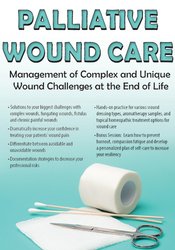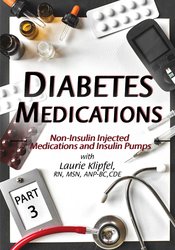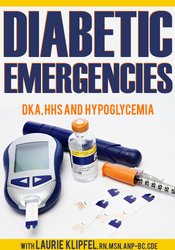What You’ll Discover in Laurie Klipfel Palliative Wound Care
Laurie Klipfel – Palliative Wound Care

The Infected Wound
Contamination and Colonization
The Best Culturing Method for Infected Patients Wound
Reduce Unnecessary Antibiotic Use
Biofilm reduction
Nutrition/Labs and their impact
Prealbumin vs. Albumin – and What to Do with the Results
Glycemic Control & Wound Healing
There are many ways to increase your nutritional intake
How to choose a Debridement method
Autolytic
Download immediately Laurie Klipfel – Palliative Wound Care
Enzymatic
Mechanical
Conservative Sharp
Maggot Therapy
Wound Types and Etiologies
Pressure Ulcers and Staging
Pressure… Seeing the Tip of the Iceberg
Tools to predict pressure ulcer risk
Deep Tissue Injury Early Detection
Incontinences Associated Dermatitis vs. Pressure Ulcers
Venous Stasis Ulcers
Where does all this fluid come from?
Lymphedema
Feeling the Squeeze… Different Degrees of Compression
Arterial Ulcers
Arterial Perfusion
Claudication and Rest pain
Vascular Studies and ABIs: Diagnostic Tests
Diabetic/Neuropathic Ulcers
Assessment of Sensation
Bad to the Bone… Osteomyelitis
Skin Tears/ Adhesive Injury
What is the extent of Thickness Loss?
Manage Xerosis With Products in Your Kitchen
Moisturizing and Skin pH…
Time out Wound Types from Actual Patient Photos
Understanding the endless options of dressing
Foams
Hydrofiber and alginates
Hydrogels
Thin Films
Negative Pressure Wound Therapy
Honey: The Magic of Honey
Contact Layers
Other Homeopathic Approaches Wound Care
Hands-Take part in an Interactive Session Intensive: Wound Products & Homeopathic Treatments
Management of End-of-Life Wounds
Drainage Management
Bleeding and Use Of Monsels Solution
Metronidazole Use and Odor
Disfigurement and loss of being touched
Skin Failure
How to recognize it
How to Document It
How to Explain to Caregivers What’s Happening
Recognizing unusual wounds
Management of Malignant/Fungating Wounds
Calciphylaxis
Pyoderma Gangrenosum
Kennedy Ulcerations
Pruritis and Xerosis
Time Out: Management of Unavoidable Wounds & Actual Patient Scenario Discussion
Fistula Solutions
Odor and Effluent Containment
Protecting surrounding tissue
Fistula Containment Management System: Hands-On Fistula Management Systems
Understanding Wound Treatment options for pain
What is the Type of Pain?
How to Reduce Pain with Dressing Adjustments/Wound Care
Use of topical opioids Wound Pain
Documentation Strategies to Unavoidable Wounds
Describing the Patient Function and Charting the Patient Decline
Documenting Prevention Strategies
Discussions with Family and Patient about Realistic Results
Avoiding Wound Care Litigation
Compassion Fatigue vs. burnout
Identify Your Stress and Anxiety
Suffering Everyday
How Stress & Guilt Affect Your Body
Building resilience
A sense of hope and optimism
Life Balance Exercise: Building a Personal Resiliency Plan
Would you like to be contacted? Laurie Klipfel – Palliative Wound Care ?
Description:
Download immediately Laurie Klipfel – Palliative Wound Care
Your biggest problems with chronic painful, fungating, and complex wounds?
Dramatically increase your confidence in treating your patients’ wound pain
It is important to distinguish between avoidable from unavoidable injuries
Documentation strategies to reduce professional risks
Hands-On practice for different types of wound dressings, aromatherapy samples, as well as topical homeopathic treatments for wound care
Bonus Session. Learn how you can prevent burnout, compassion fatigue, and create your own personal plan of action.-Take care of your resilience
Do you ever feel frustrated or helpless caring for end-of-life patients who have suffered from unavoidable and horrific injuries? Are you ever told that there is nothing you can do to help a dying patient? It is absolutely false! It is important to keep our patients happy, healthy, and comfortable. Patients and caregivers can feel overwhelmed by the effects of cancer, skin disease, or vascular insufficiency. This seminar will provide an overview of the topic.-An in-depth approach to palliative and end-of life care. With confidence, compassion, and knowledge you will be able to care for patients with difficult wounds at the end of your life.
Wound You will see real patients and will hear about their experiences. Case studies will also be presented to highlight important points. Based on the various presentation styles and etiologies, you will be able to learn how to select the right dressing and when debridement should be used. Formulary creation will also be discussed. There will be “hands-on” There are many opportunities to try out different types of wound dressings, as well as new homeopathic treatments. This includes-depth seminar is “useable” This information will help you quickly become a valuable resource to your team and can be applied in your care of the most complicated wound patients.
Download immediately Laurie Klipfel – Palliative Wound Care
IMPORTANT: This is it. “Laurie Klipfel – Palliative Wound Care” Completely Downloadable We will make your link available immediately. We appreciate your patience.








